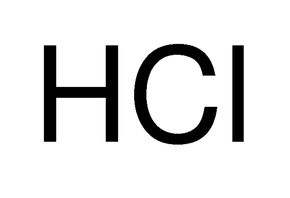Acids & Bases
Hydrochloric acid (30723)
min. 25%, analytical reagent
Please sign in to access more documents
Once signed in, you may be able to access additional documents for your account.
General Information
- Application
- Lab chem
- CAS Number
- 7647-01-0
- Concentration
- >= 25 % to < 50 %
- EC Number
- 231-595-7
- Grade
- puriss. p.a.
- Linear Formula
- HCl
- Molar Mass
- 36.46 g/mol
- Product Type
- Mixture Degrees Celsius
- Synonyms
- Hydrogen Chloride
- Muriatic Acid
- UNSPSC Code
- 12352301
Physical Properties
- Boiling Point/Range
- No data available
- Chemical Composition
- hydrochloric acid
- Color
- Colorless
- Density
- 1.120 g/cm3 (20 °C)
- Flashpoint
- Not applicable
- Melting Point/Range
- No data available
- Odor
- Stinging
- Partition Coefficient
- No data available
- pH
- Acidic
- Physical Form
- Crystalline powder
- Solubility in Water
- Completely miscible
Safety Information
- Chemical Stability
- Stable under normal conditions.
- Corrosivity
- Corrosive to metals
- Evaporation Rate
- No data available
- Ignition Temperature
- Not applicable
- Incompatible Materials
- Gives off hydrogen by reaction with metals, Incompatible with strong bases and oxidizing agents, Ammonia, Amines
- Self Ignition
- Not applicable
- Thermal Decomposition
- No decomposition if used as directed.
International Transportation
- Chemical Class
- 8
- Harmonized System Code
- 28061000
- Packing Group
- II
- UN Number
- 1789
General Information
- Application
- Lab chem
- CAS Number
- 7647-01-0
- Concentration
- >= 25 % to < 50 %
- EC Number
- 231-595-7
- Grade
- puriss. p.a.
- Linear Formula
- HCl
- Molar Mass
- 36.46 g/mol
- Product Type
- Mixture Degrees Celsius
- Synonyms
- Hydrogen Chloride
- Muriatic Acid
- UNSPSC Code
- 12352301
Physical Properties
- Boiling Point/Range
- No data available
- Chemical Composition
- hydrochloric acid
- Color
- Colorless
- Density
- 1.120 g/cm3 (20 °C)
- Flashpoint
- Not applicable
- Melting Point/Range
- No data available
- Odor
- Stinging
- Partition Coefficient
- No data available
- pH
- Acidic
- Physical Form
- Crystalline powder
- Solubility in Water
- Completely miscible
Safety Information
- Chemical Stability
- Stable under normal conditions.
- Corrosivity
- Corrosive to metals
- Evaporation Rate
- No data available
- Ignition Temperature
- Not applicable
- Incompatible Materials
- Gives off hydrogen by reaction with metals, Incompatible with strong bases and oxidizing agents, Ammonia, Amines
- Self Ignition
- Not applicable
- Thermal Decomposition
- No decomposition if used as directed.
International Transportation
- Chemical Class
- 8
- Harmonized System Code
- 28061000
- Packing Group
- II
- UN Number
- 1789
- Application : Lab chem
- UNSPSC Code : 12352301
- Synonyms : Hydrogen Chloride|Muriatic Acid
- Product Type : Mixture Degrees Celsius
- Molar Mass : 36.46 g/mol
- Linear Formula : HCl
- Grade : puriss. p.a.
- EC Number : 231-595-7
- Concentration : >= 25 % to < 50 %
- CAS Number : 7647-01-0
- pH : Acidic
- Solubility in Water : Completely miscible
- Physical Form : Crystalline powder
- Partition Coefficient : No data available
- Odor : Stinging
- Melting Point/Range : No data available
- Flashpoint : Not applicable
- Density : 1.120 g/cm3 (20 °C)
- Color : Colorless
- Chemical Composition : hydrochloric acid
- Boiling Point/Range : No data available
- Thermal Decomposition : No decomposition if used as directed.
- Self Ignition : Not applicable
- Incompatible Materials : Gives off hydrogen by reaction with metals, Incompatible with strong bases and oxidizing agents, Ammonia, Amines
- Ignition Temperature : Not applicable
- Evaporation Rate : No data available
- Corrosivity : Corrosive to metals
- Chemical Stability : Stable under normal conditions.
- UN Number : 1789
- Packing Group : II
- Harmonized System Code : 28061000
- Chemical Class : 8


